 |
Home | Charity | Feedback |
Ecuador:
Galapagos,
Quito
Quito, Ecuador: Experience an era gone by by Prakash Bang, Editor in Chief 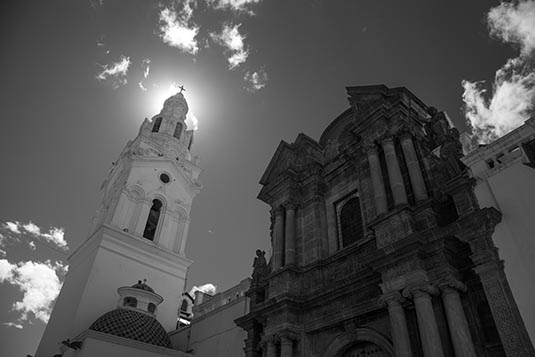 Quito, formally San Francisco de Quito, is the capital city of Ecuador. And at an elevation of 9,350 feet it is the highest official capital city in the world. Quito is situated in the Guayllabamba river basin, on the eastern slopes of Pichincha Volcano, an active stratovolcano in the Andes Mountains. 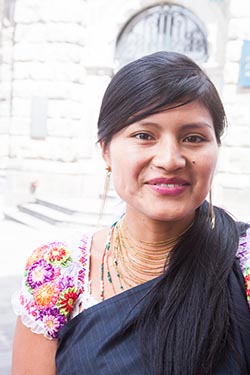 The historic center of Quito has one of the largest, least-altered and best-preserved historic centers in the Americas. It is undoubtedly one of the city’s main tourist attractions. The central square of Quito is located about 25 kms. south of the equator. The city itself extends to within 1 km of zero latitude. A monument and museum marking the general location of the equator is known locally as ‘Mitad del Mundo’ (the middle of the world). The word 'ecuador' stands for ‘equator’ in Spanish.
The historic center of Quito has one of the largest, least-altered and best-preserved historic centers in the Americas. It is undoubtedly one of the city’s main tourist attractions. The central square of Quito is located about 25 kms. south of the equator. The city itself extends to within 1 km of zero latitude. A monument and museum marking the general location of the equator is known locally as ‘Mitad del Mundo’ (the middle of the world). The word 'ecuador' stands for ‘equator’ in Spanish.
We arrived in Quito late in the afternoon from Baltra Islands, Galapagos. The newly built airport is about an hour's drive from downtown. And it all depends on traffic. The old airport was in the middle of the valley, making it the second hardest airport to land-in and take-off from. The first being Hong Kong's old airport. We preferred staying in the Old Town and the hotel of choice was Casa Gangotena. It's a boutique award-winning 31-room property. I would describe Casa Gangotena as sophisticated and eclectic; historic yet contemporary - a place where style and service blend seamlessly and delightfully. The hotel certainly has my recommendation for visitors planning to spend a few nights in Quito. 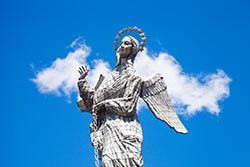 The Old Town is a perfect criss-cross of narrow streets. Almost every street in town is one-way. I was delighted seeing the driving skills of our bus driver as well as other vehicles on the street. And since the town is located on the hill slope, it's a roller coaster walk... up and down. Reminded me of San Francisco streets of USA, albeit much narrower.
The Old Town is a perfect criss-cross of narrow streets. Almost every street in town is one-way. I was delighted seeing the driving skills of our bus driver as well as other vehicles on the street. And since the town is located on the hill slope, it's a roller coaster walk... up and down. Reminded me of San Francisco streets of USA, albeit much narrower.
That evening we walked about 3 blocks down to Calle de la Ronda. This street in the Old Town was restored by the local authorities in 2007. It was transformed with the help and cooperation of the local residents. It's a romantic cobbled street just off the Plaza Santo Domingo (or it can be reached via Garcia Moreno by the City Museum). There are shops, patios, art galleries and modest cafe restaurants, all run by residents. Street artists perform out there, especially during weekends. Quite a romantic setting. 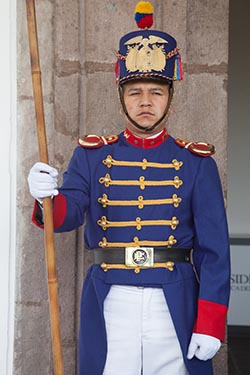 Dinner that night mainly constituted of a favourite local cuisine - potato soup and a kind of corn bread fried to perfection and sprinkled with powdered sugar. Almost everybody in my group was a strict vegetarian... that's quite a challenge to handle especially when travelling in South America.
Dinner that night mainly constituted of a favourite local cuisine - potato soup and a kind of corn bread fried to perfection and sprinkled with powdered sugar. Almost everybody in my group was a strict vegetarian... that's quite a challenge to handle especially when travelling in South America.
For our return trip to the hotel, we took a cab as we had no energy to walk up. The taxis in Quito are plenty and relatively cheap. A trip in Old Town will never cost you more than $2. By the way, the official currency in Ecuador is USD. They migrated to the greenback in the year 2000 when the inflation was at its peak. Their then local currency Sucre was in the pits. You got about 25000 Sucre for 1 USD. So be it. Because of Quito's elevation and its proximity to the equator, the city has a fairly constant cool climate. The annual average temperature is 14 °C. Throughout the year, the city is considered to have two seasons: winter and summer. Winter is usually very rainy, especially during the month of April. Summer becomes very dry and windy. Once the sun goes down it can get downright cold, so dressing in layers is a good idea. A common first time visitor's mistake is assuming that since the city is near the equator, the climate is going to be really hot, and doesn't bring along warmer clothes. 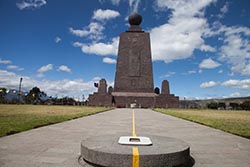 For those on their own and wanting to spend more days in Ecuador, it would be a good idea to pick-up some basic Spanish in order to get along. Quito is an excellent city in which to learn Spanish. The Spanish spoken in Quito is very clear and it is spoken slowly in comparison to coastal areas. Dozens of Spanish-learning institutions have locations all around town. On our ship in Galapagos we had a few students from the USA who had come to Quito to learn Spanish.
For those on their own and wanting to spend more days in Ecuador, it would be a good idea to pick-up some basic Spanish in order to get along. Quito is an excellent city in which to learn Spanish. The Spanish spoken in Quito is very clear and it is spoken slowly in comparison to coastal areas. Dozens of Spanish-learning institutions have locations all around town. On our ship in Galapagos we had a few students from the USA who had come to Quito to learn Spanish.
After breakfast and pack-up the next morning we would visit Panecillo hill and thereafter walk the Old Town. The Old Town continues to be Quito's main attraction - it boasts no fewer than 40 churches, 17 plazas and 16 convents and monasteries (many of these with guided tours). It's been called the 'Reliquary of the Americas' for the richness of its colonial and independence-era architecture and heritage. It's a great district to wander, with several excellent museums, theatres, and plenty of restaurants and terrace cafes for a rest while sightseeing. 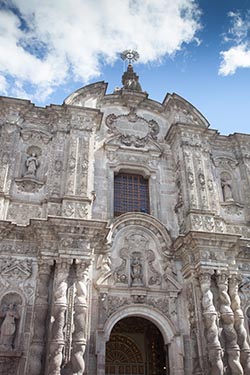 La Virgen del Panecillo is adjacent to the Old Town. El Panecillo is a hill on top of which is La Virgin del Panecillo, a large statue of the 'winged' Virgin Mary. She can be seen from most points in the city and is believed to protect the city, especially from earthquakes. We drove all the way up and then walked around the statue. The location offers panoramic views of the city below. We were warned never to walk up to the hill like the locals as that can be dangerous. Buses and taxis are the best options for tourists.
La Virgen del Panecillo is adjacent to the Old Town. El Panecillo is a hill on top of which is La Virgin del Panecillo, a large statue of the 'winged' Virgin Mary. She can be seen from most points in the city and is believed to protect the city, especially from earthquakes. We drove all the way up and then walked around the statue. The location offers panoramic views of the city below. We were warned never to walk up to the hill like the locals as that can be dangerous. Buses and taxis are the best options for tourists.
The Church of San Francisco, is the most imposing of all Quito's architectural monuments - a temple, a series of chapels, and a convent. All this together takes up nearly two blocks, and rises up above a wide stone paved court. Shortly after the foundation of the city in 1536, Fray Jodoco Ricke began the construction of the temple and the convent, helped by architects and craftsmen like Fray Francisco Benitez, who was in charge of the work throughout the last quarter of the sixteenth century and finished it off in 1605. He also carved the benches and the figures of the choir. 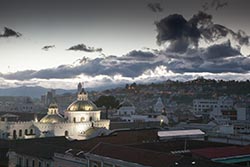 The atrium runs from one side of the square to the other, and the facade of the temple and convent rise above it, with a high retaining wall built of solid stone and interrupted in the middle to give access to the plaza by means of a double fan shaped staircase. The facade of the church is austere, in accordance with the Renaissance canons of Greco-Roman neo-classicism. The lower part has a line of Doric columns which merge with the retaining wall, the upper has slightly shorter Ionic columns.
The atrium runs from one side of the square to the other, and the facade of the temple and convent rise above it, with a high retaining wall built of solid stone and interrupted in the middle to give access to the plaza by means of a double fan shaped staircase. The facade of the church is austere, in accordance with the Renaissance canons of Greco-Roman neo-classicism. The lower part has a line of Doric columns which merge with the retaining wall, the upper has slightly shorter Ionic columns.
The Jesuit began work on their church (La Compania church) in Quito in 1605. Marcos Guerra arrived in the city about 1613, and he corrected the mistakes what had so far been done, and gave the final overall shape to the construction. Work began on the facade in 1772. The facade is a marvel of the American baroque and plateresque styles. Six columns of Salomon flank the main entrance, and this was the first time that these pillars had been incorporated into American architectural styling. 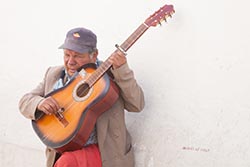 Corinthian pillars stand by the side doors. Below them are carved Renaissance panels. Sun and leaves decorate the frieze, and the cornice appears to be supported by acanthus leaves. The cornice takes on the form of an arch over the main door, and contains a niche with a statue of the Virgin, surrounded by cherubim and angels.
Corinthian pillars stand by the side doors. Below them are carved Renaissance panels. Sun and leaves decorate the frieze, and the cornice appears to be supported by acanthus leaves. The cornice takes on the form of an arch over the main door, and contains a niche with a statue of the Virgin, surrounded by cherubim and angels.
The stone to build the present day La Catedral was brought down from Mount Pichincha, and with the enthusiastic collaboration of those who lived in the neighbourhood, work was completed between 1562 and 1565. Later on, the altar-pieces were made and the pulpit carved. The temple was dedicated in 1572. Nevertheless, what we see today, is the result of work carried out through the seventeenth and eighteenth centuries. 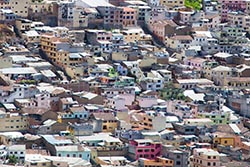 Our next stop in the Independence Square was the Presidential Palace. This building was erected between the 18th and early 19th Centuries by the President of the Royal Council, Baron Hector de Carondelet. On the staircase landing which leads to the first floor, there is a mural painted by the Ecuadorian artist Oswaldo Guayasamin, which portrays the discovery of the Amazon River on 12th February 1542. The third floor of the palace is used as the President's private quarters where he lives along with his family. The building has many corridors and reception rooms which are used for official occasions. Access to the top floors is restricted and it is only possible to visit the ground floor of the building.
Our next stop in the Independence Square was the Presidential Palace. This building was erected between the 18th and early 19th Centuries by the President of the Royal Council, Baron Hector de Carondelet. On the staircase landing which leads to the first floor, there is a mural painted by the Ecuadorian artist Oswaldo Guayasamin, which portrays the discovery of the Amazon River on 12th February 1542. The third floor of the palace is used as the President's private quarters where he lives along with his family. The building has many corridors and reception rooms which are used for official occasions. Access to the top floors is restricted and it is only possible to visit the ground floor of the building.
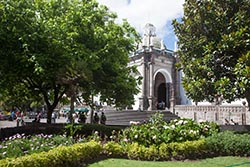 The next on our map was a visit to Mitad del Mundo. Just outside of Quito (a 45-minute drive) is where the measurements were first made that proved that the shape of the Earth is in fact an oblate spheroid. Commemorating this is a large monument that straddles the equator called Mitad del Mundo or middle of the world. Note, however, that the true equator is not at the Mitad del Mundo monument. Through the magic of GPS technology, we now know that it is only 240 meters away. Well, a few metres deviation did not take away our excitement of taking pictures with one leg in the northern hemisphere and the other in southern!
The next on our map was a visit to Mitad del Mundo. Just outside of Quito (a 45-minute drive) is where the measurements were first made that proved that the shape of the Earth is in fact an oblate spheroid. Commemorating this is a large monument that straddles the equator called Mitad del Mundo or middle of the world. Note, however, that the true equator is not at the Mitad del Mundo monument. Through the magic of GPS technology, we now know that it is only 240 meters away. Well, a few metres deviation did not take away our excitement of taking pictures with one leg in the northern hemisphere and the other in southern!
It was now time to leave for the airport. We had a late afternoon flight that would take us to Lima, Peru. Quito Image Gallery  Photo viewer Photo viewer
|
|
|
Home |
Charity |
Feedback
Privacy Policy | Terms of Usage © YoGoYo.com. All rights reserved. |















































